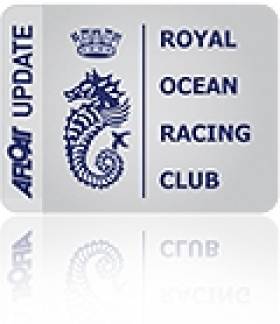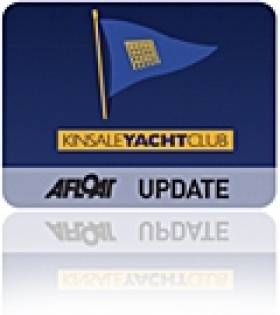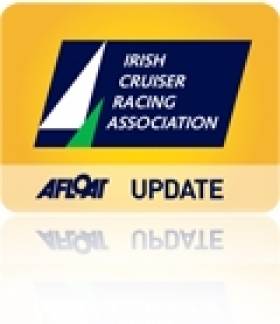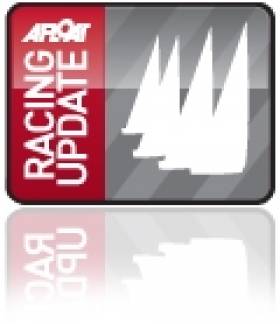Displaying items by tag: antix
With a slow moving front passing across the Solent today, the fleet competing at the RORC's IRC Nationals were subjected to one of the windiest days they have seen so far this season.
Three races were held on the central Solent and with the wind gusting into the 30s for today's final encounter, there were a multitude of DNSes and DNFes. While there were at least two dismastings on the Solent, fortunately the carnage in the IRC Nationals fleet was limited principally to sails and fittings, while those that did last the course were to be commended for their prudence, the majority for example choosing not to hoist the kites in the blustery final race.
Former Volvo Ocean Race skipper Bouwe Bekking, competing on board Willem Wester's Grand Soleil 46, Antilope, in IRC 1, said the most wind they saw was 32 knots. "That's fun and it is good that they keep us racing in that, because it brings seamanship back to everyone." Bekking said that they continued to use their spinnaker today but the lighter weight asymmetric boats, able to hoist large genoas on the reaches, were able to sail four or five knots faster than they were. For the most part today Antilope came away unscathed, although they suffered a small rip in their mainsail.
Antilope was one of only five boats in IRC 1 to complete the final race. Crucially one of the DNFs was Jonathan Goring's overnight leader, Keronimo, so the lead in the highly competitive IRC 1 has now passed to Anthony O'Leary and his Irish Rolex Commodores' Cup winning crew aboard the Ker 39, Antix.
Of course loving today's brisk conditions was Dutch salty seadog Piet Vroon, skipper of Tonnerre de Breskens 3, who's 3-1-1 scoreline was the most consistent of the day. His blue hulled Ker 46 now holds second place in IRC 1 two points astern of Antix and two ahead of Keronimo.
This is not the first time the well-travelled Tonnerre has encountered such conditions. "The boat goes better with a lot of wind," admitted Vroon. "And yes, we have seen these conditions occasionally. The boat did everything that was expected. Whether the crew did or not...!"
With more breeze forecast for tomorrow, Tonnerre could be in with a good chance of repeating her IRC Nationals class victory from two years ago, when she was just four weeks old.
While Johnny Vincent's modified TP52, Pace, continued her unbroken string of wins in IRC 0 against Rob Grey and Sam Laidlaw's Farr 52, Bob, both choosing to stand down from today's final race, so in IRC 2 Peter Rutter's Grand Soleil 43, Quokka 8, now has scored a phenomenal six bullets in as many races. Fighting for the remaining podium positions going into tomorrow's final two races are Nicolas Gaumont-Prat's First 40.7, Tradition Philosophie IV, Jim Macgregor's Elan 410, Premier Flair, and Richard Fildes' Corby 37 Impetuous.
Unfortunately in today's second race Jim Macgregor's Premier Flair suffered a contretemps with Peter Morton's MAT1010 sailing in IRC3. Morton recounted the incident: "They went around the top mark, hoisted and did a massive roll to windward - they almost did a Chinese gybe on top of us! We were on port and they were on starboard, but we were a long way away but they did this huge roll to weather and hit the top of the rig."
MAT1010 retired from that race but bounced back to win today's breezy third. In one gust Morton said they had seen 34 knots and at one point when they had the kite up they clocked 19 knots - not bad for a 33 footer.
With Chris and Hannah Neve's No Chance disqualified from yesterday's second race due to a start line infringement that ended up in the protest room, followed by an OCS in today's second race, so the leader in IRC 3 is now Mike Bridges' Elan 37, Elaine.
"We were just trying to keep it safe today," admitted Bridges, so says that for this regatta they are sailing with a mixed crew and don't have their usual amount of hiking weight on the rail. "We just wanted to get around and stay close to people."
Bridges says that Elaine likes "anything between 12 and 20+ knots, but 30 is probably a bit much!" Today they managed to avoid too much carnage although the conditions did take their toll and they blew out a fitting for the vang. "We had to replace that on the way. Otherwise there was nothing major," said Bridges.
In IRC 4 Adam Gosling's Corby 30, Yes! has been propelled into the lead following bullets in today's final two races, while yesterday's leader Michael Kershaw's Half Tonner, Chimp, was one of four boats in the class to bow out of today's final race, dropping her to second.
A final two races are scheduled for tomorrow and at the forecast at present is showing at least as much wind as we have seen today
Sovereign's Cup 2005 - Photo Review
Anthony O’Leary’s Corby 35 ‘Antix’ won sailing's Sovereign’s Cup at Kinsale Yacht Club, and Paddy Gregory’s Elan 31 ‘Benola’ the Portcullis Trophy. Eamon Conneely’s Transpac 52 ‘Patches’ was the winner in Division 0 IRC, gaining National Champion title for that Division and the Saab Trophy for IRC.
‘Antix’ was the yacht deemed by the organising committee to have put in the best overall performance under IRC across the four fleets. She and Eamon Crosbie’s ‘Voodoo Chile’ had quite a duelling match in Division 1, with ‘Antix’ emerging as National Champion. ‘Benola’ finished first overall in both IRC and Echo in Division 2, winning double National Championship titles. Neil White’s Sigma 400 ‘Barafundle of Mumbles’ was the Division 1 winner and Champion.
Photos of the 2007 event by Bob Bateman BELOW:
Commodores' Cup Boats Jointly Awarded Boat of the Year Award
There was a strong seal of approval from sailing delegates at the ICRA Conference yesterday evening for the decision to award the Boat of the Year prize to all three Royal Cork boats from the winning Irish Commodore's Cup team.
Antix, Marinerscove and Roxy lifted the trophy to loud applause at the Carrigaline Court Hotel, the venue for ther eighth annual meeting of Irish Cruiser Racer interests. Last night Commodores Cup celebrations continued at the Royal Cork Yacht Club at a special dinner in honour of the team who brought home the cup after more than a decade of attempts.
In announcing their decision the ICRA judging team stated that as there was 'no way they could split the RCC boats that made up the winning team' this summer. The decision had been expected given the importance of the international victory in Cowes.
Earlier this month a readers poll on Afloat.ie that attracted nearly 3,000 votes showed an offshore yacht Raging Bull from Skerries to be a popular choice for the trophy. HERE. Discussion HERE. It's an indication of the widening appeal of a part of the sport that has been rekindled on the Irish Sea.

ICRA's Boats of the Year: The Cork team that won the Commodore's Cup. Montage by Bob Bateman
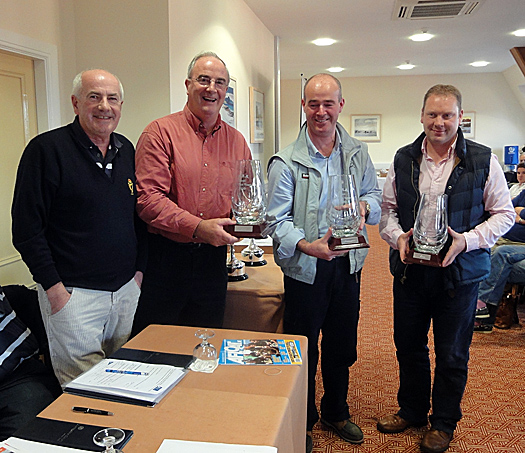
Winning Trio: ICRA Commodore Barry Rose (left) with skippers Anthony O'Leary, Dave Dwyer and Andrew Creighton. Photo by Peter Ryan
Commodores' Cup Celebration Dinner to be Held at Royal Cork
Team Ireland boats, Antix - Anthony O Leary, Marinerscove.ie - Dave Dwyer and Roxy 6 - Rob Davies and Andrew Creighton, will be represented on the night.
The dinner cost will be €30 and booking will be on first come/first served basis. Book with [email protected] or call 021 4831023.
Who Will Win ICRA's Boat of 2010?
Will it be Antix, Marinerscove or Roxy's year? It might be hard to ignore the sailing performance of 2010 but there have been some fine non-Commodore's cup performances too. The judges decision may well be final at the Irish Cruiser Racer Association (ICRA) conference on November 13th but before then we're taking our annual look down the likely candidates and letting YOU decide who you think should be Boat of the Year. Vote now in our Poll on the left hand column of the home page!
1720s Ready for Cork Harbour October Contest
Ten 1720s will contest Sunday's first race of Royal Cork's October league in force. The 2010 league marks the return of these sports boat to Cork Harbour but it comes at the expense of the club's three Commodore's cup boats originally planning to take part.
At least two 1720s are entered by the O'Leary family which almost certainly means the Ker 39 Antix will stay on its berth. Peter O'Flynn from Baltimore is sailing and other 1720 entries have been received from Tom Durcan and Denis Murphy.
Following the successful Commodore's Cup campaign Marinerscove is now in the UK and Andrew Creighton has indicated the small boat Roxy will not be sailing.
There have been a few tweaks to the format of the league and this year there will be two courses both starting with committee boats.
Competitors from other south coast ports such as Waterford Harbour SC arrived in Crosshaven this week.
Course Zero, One and Two and 1720 designated as Red Fleet while classes three, four, Whitesail One and White sail Two will be designated Green Fleet and the classes will alternate between the courses each weekend.
Prizes will be awarded for first, second and third place in each class and a daily prize giving will take place no later then 17.30 hrs in the RCYC Club House. The final prize giving will take place at the prize giving gala dinner on Saturday, October 30th.
O'Leary Continues Lead in 1720 Nationals
Anthony O'Leary continues to lead at the Irish 1720 National Championships hoste by Baltimore Sailing Club writes Claire Bateman. After four races sailed on Friday and one discard applied the results are: 1. Anthony O'Leary, Antix 3 pts: 2. Neil Hogan, Micam, 8 pts: 3. Ben Cooke, Smile 'n wave, 12pts: 4. Robert O'Leary, Wet 'n Ready, 15 pts: 5. Michael Wilson, Yknot 16pts.
Unstoppable Ireland Win 2010 Commodores' Cup
Ireland has won the 2010 Commodores' Cup but it was not without final race drama this morning. According to reports from the race course, Team Captain Anthony O'Leary was in a collision before the start of the race with a French competitor when winds gusted to 30 knots.
The news that Ireland has won the Cup is already being celebrated in Crosshaven this lunch time, the home of the three boat team.
The winning Ireland team from Royal Cork was Antix, Anthony O'Leary (Ker 39); Marinerscove.ie David Dwyer (Mills 39) and Roxy 6 Robert Davies (Corby 36).
After a series of near misses in the Commodore’s Cup, there are many reasons why 2010 was entirely appropriate timing for the Irish win in Cowes this week.
Ireland fielded a single three boat team instead of its previous two and three team approach. Individual performances this season though, including a win at the British IRC Nationals were early indicators that Ireland still had the will to win the Commodore's Cup.
And it was obvious this week from the first inshore race on Sunday that Ireland would take a lot of stopping.
To send your congratulations to the Irish team click here
To join our forum thread click here
Update: Ireland Going Well In Round the Island Race
Ireland is off to a great start this morning in the Round the Island Race. ICRA Commodore Barry Rose is out by the Needles. He says: "Antix is doing super in Class 1. Mariners is fourth on the water and ahead of most her Class One. Roxy second to Rockall, probably third in class" More as we have it.
keep up to date here:
http://commodorescup.rorc.org/fleet-tracking/2010-live-offshore-tracking.html
Send good luck messages here:
http://www.afloat.ie/commodores-cup/item/13716-commodores-cup-send-your-good-luck-wishes-here/
Ireland Continue to Lead Commodores' Cup
Two race wins and a third place for the Irish Cruiser Racing Association (ICRA) team at Cowes have extended Ireland's lead by ten points overnight as the event reaches its penultimate phase tomorrow with the Round Isle of Wight Race. Strong winds gusting to 25 konts are forecast and the team is focussed on avoiding damage.
Ireland has a 40.5 point lead over second placed Hong Kong and 49 points over third-placed France Blue.
Team Captain Anthony O'Leary on Antix won Class 1, continuing his consistent form of race wins and second places this week. Roxy 6 skippered by Andrew Creighton benefitted from an apparent navigational error by Hong Kong's Rockall III that was leading comfortably in Class 3 until a course change was missed and the Irish team boat won the race. Dave Dwyer's marinerscove.ie placed third in Class 2 in a race dominated by British boats La Reponse and Quokka 8.
"We have a very workman like approach to prepararing thoroughly for the 50-miler tomorrow," commented Barry Rose, Commodore of ICRA. "The course has lots of complicated corners and we expect it to be breezy. Its a big challenge that we're taking day by day; our plan goes on as it has from the beginning, concentrating on every detail to be as prepared as we can."
The race around the island counts for 1.5x bonus factor and will be especially tough in the forecast conditions. "The race around the Isle of Wight is going to be pretty long and pretty tough for the small boats," Maurice O'Connell, mainsheet trimmer on Roxy 6. "We're just going to keep doing what we're doing and hope that it all comes good."
A grim overcast start and lumpy wind against tide conditions gave way to brilliant sunshine and a summery finish off the Royal Yacht Squadron for the Rolex Trophy Day inshore race at the 2010 Rolex Commodores' Cup. Today's one race was held around multiple marks in the central western Solent starting in 18 knot southwesterlies with a wet beat through short chop before the tide turned and the wind dropped gradually through the race, ending at below 10 knots .
It was another solid day for the Irish team, leaders since the opening day of the regatta last Sunday. Their big boat, Anthony O'Leary's Ker 39 Antix and their small boat, Robert Davies' Corby 36 Roxy 6 both won their classes today while David Dwyer's marinerscove.ie posted a third. No other team was close to being as consistent today.
In the small boat class Roxy 6 came out on top partly thanks to a navigation error on the Hong Kong boat, Christopher Opielok's Corby 36 Rockall III [at the time of going to press this was subject to a protest for redress]. "We were very lucky," said Roxy 6's helmsman Andrew Creighton. "Rockall went to a wrong mark and they were ahead of us. With them making that mistake it obviously pushed us into first, although one of the French guys, Goa, came very close to us, but we had them by about 25 seconds."
Roxy 6 was only launched in April, but has had an intensive season at regattas throughout the UK and her native Ireland. Designed by Cowes resident John Corby, the 36 footer relished today's conditions. "The short Solent slap suits this sort of boat," said Creighton.
Back at Cowes Yacht Haven, Commodore of the Royal Ocean Racing Club, Andrew McIrvine stepped off the boat he co-owns with Peter Morton in buoyant mood. His Beneteau First 40.7 La Réponse won the mid-sized class today by two and a half minutes on corrected time ahead of past RORC Commodore Peter Rutter's Quokka 8.
"We just went fast," said McIrvine explaining today's result. "Upwind we go higher and faster than we ought to for this size of boat if you consider it is a cruiser racer. Downwind we go quick too. It is a semi-standard production boat and it does go extremely well." McIrvine acquired the boat this year from past Rolex Commodores' Cup winner Géry Trentesaux and has changed the bulb keel back to a fin but kept the go-faster carbon fibre mast.
"Tactically we didn't make any mistakes. The crew are fantastic. All the gybe sets worked perfectly. There were no foul-ups on any of the manoeuvres. They are a very well tuned team now," added McIrvine.
Second behind Antix, Bernard Gouy's Inis Mor in France Yellow had their best day yet, making it a Ker 39 1-2 in the big boat class today.
"Our spinnaker legs were better today with the asymmetric [spinnaker]," stated Laurent Gouy, the owner's son. "We have some difficulty when it is really downwind and when it is wavy we can compensate to slide downwind a bit better."
Behind them in third, the Hong Kong big boat EFG Bank Mandrake posted their best result of the regatta today. "I thought it was superb," said Nicholas Burns, co-owner with Fred Kinmonth. "I think we sailed as good a race as we could have done. We tacked about 20 times on top of Antix and she still beat us! She is going very fast at the moment, so I think our tactics will change now. We'll just go for the best position we can and not try and knock the Irish back."
As to the regatta generally, Burns said: "Very challenging, superb sailing, all the competition is extremely good and we're really enjoying it. It is colder than we are used to. We are used to Asian temperatures of 29-33 degrees Celsius. We have lots of warm ski gear on, but it has been really good fun."
EFG Bank Mandrake, a Mills 40 design, previously raced at the Rolex Commodores' Cup in 2006 as an Irish entry under the name Tiamat. She was shipped to the UK from Palma especially for this regatta and will head to Hong Kong afterwards. "It is great fun," says Burns of the regatta. "It is nice to have a team race with three boats in different classes. It is a really good idea. You feel you are sailing some of the best sailors in the world which is challenging."
At the end of play today the Hong Kong team lies second to the runaway Irish, but have been knocked back due to their small boat Rockall III's mishap, causing her to finish ninth (depending upon the outcome of their protest). From being 30 points astern of the Irish yesterday, the Hong Kong team is currently 40.5 points behind them. However the regatta is far from over with a race around the Isle of Wight coming with a x1.5 points co-efficient tomorrow (Friday) and a double points scoring inshore race to conclude the regatta on Saturday.
As RORC Commodore Andrew McIrvine puts it, "although the Irish have got away there is still almost half the points to play for. The weighting keeps the whole thing open right to the end of the event. At a lot of regattas by this stage it is signed sealed and delivered. We have still got a long way to go."
Conditions for the race around the Isle of Wight look set to be brisk with southwesterly winds gusting up to 25 knots forecast.
Crews competing at the Rolex Commodores' Cup will return to offshore mode tomorrow. The Irish will look to consolidate their dominance, whilst those chasing, particularly Hong Kong, will look to take advantage of any errors by the all but impeccably sailed leaders.
Top Five Teams - Provisional Positions after completion of 6 races
Team / Points / Place
Ireland / 47 / 1
Hong Kong / 87.5 / 2
France Blue / 96/ 3
GBR Red / 103 / 4
France Yellow /110 / 5



























